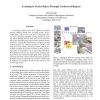Free Online Productivity Tools
i2Speak
i2Symbol
i2OCR
iTex2Img
iWeb2Print
iWeb2Shot
i2Type
iPdf2Split
iPdf2Merge
i2Bopomofo
i2Arabic
i2Style
i2Image
i2PDF
iLatex2Rtf
Sci2ools
WACV
2005
IEEE
2005
IEEE
Learning to Track Objects Through Unobserved Regions
As tracking systems become more effective at reliably tracking multiple objects over extended periods of time within single camera views and across overlapping camera views, increasing attention is being focused on tracking objects through periods where they are not observed. This paper investigates an unsupervised hypothesis testing method for learning the characteristics of objects passing unobserved from one observed location to another. This method not only reliably determines whether objects predictably pass from one location to another without performing explicit correspondence, but it approximates the likelihood of those transitions. It is robust to non-stationary traffic processes that result from traffic lights, vehicle grouping, and other non-linear vehicle-vehicle interactions. Synthetic data allows us to test and verify our results for complex traffic situations over multiple city blocks and contrast it with previous approaches.
| Added | 25 Jun 2010 |
| Updated | 25 Jun 2010 |
| Type | Conference |
| Year | 2005 |
| Where | WACV |
| Authors | Chris Stauffer |
Comments (0)

